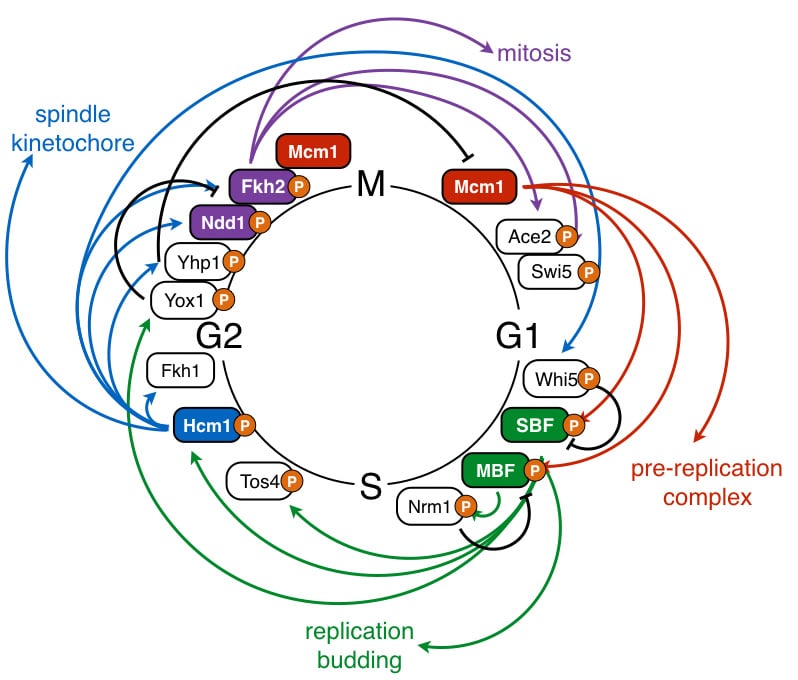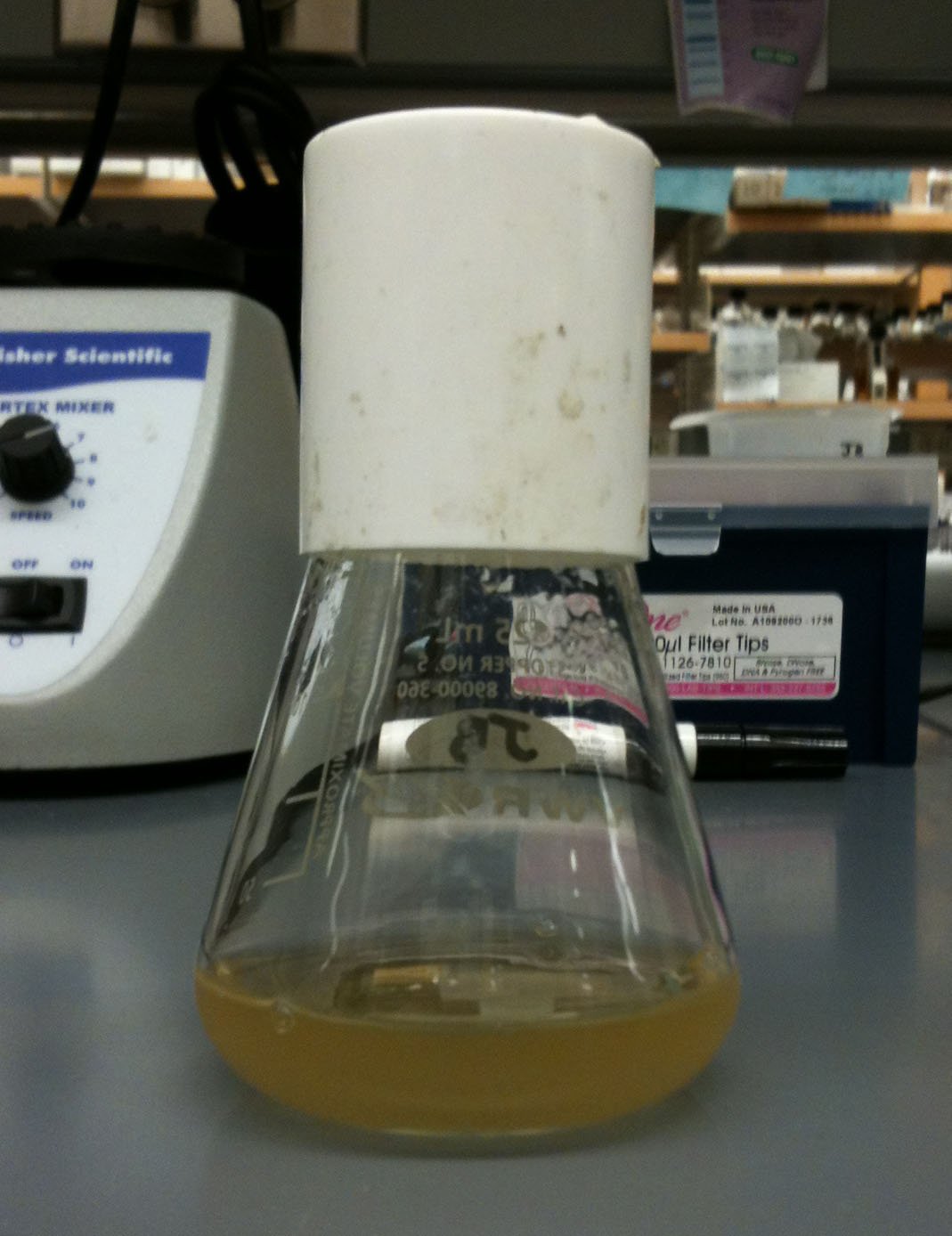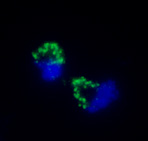Our Research
Accurate cell division is essential for the growth and development of all organisms, and because of this, many critical steps in the cell cycle are controlled by overlapping or redundant mechanisms. The cell cycle is regulated at three levels–transcription, protein degradation, and phosphorylation–all of which are important to order cell-cycle events. Our goal is to understand how these different modes of regulation are integrated to generate a robust control network. A better understanding of this network will enable us to identify regulatory steps that can be targeted to inhibit proliferation and develop more effective cancer therapies.
Cell-cycle regulated transcription
 Progression through the cell cycle is driven by a carefully orchestrated and precisely ordered gene expression program. This gene expression pattern is established by a network of conserved transcription factors (TFs), many of which are misregulated in cancer cells. The activities of these TFs are regulated by cyclin-dependent kinase (CDK), resulting in carefully timed expression of cell cycle-regulated genes. Our lab studies how CDK phosphorylation controls the activities cell-cycle regulatory TFs (Landry et al, EMBO J, 2014; Marceau et al, eLife, 2019). We utilize systems-level genetic approaches to determine how TF phosphorylation impacts cellular physiology and are developing methods to decode multi-phosphorylated domains to identify the critical phosphorylation sites that impact protein function.
Progression through the cell cycle is driven by a carefully orchestrated and precisely ordered gene expression program. This gene expression pattern is established by a network of conserved transcription factors (TFs), many of which are misregulated in cancer cells. The activities of these TFs are regulated by cyclin-dependent kinase (CDK), resulting in carefully timed expression of cell cycle-regulated genes. Our lab studies how CDK phosphorylation controls the activities cell-cycle regulatory TFs (Landry et al, EMBO J, 2014; Marceau et al, eLife, 2019). We utilize systems-level genetic approaches to determine how TF phosphorylation impacts cellular physiology and are developing methods to decode multi-phosphorylated domains to identify the critical phosphorylation sites that impact protein function.
Rewiring of the cell cycle in response to environmental stress
When cells are exposed to an environmental stressor, the cell cycle is delayed until they adapt to their new environment. We are interested in understanding how stress response pathways interface with the cell cycle-regulatory network to pause the cell cycle as cells adapt. Our work has shown that the phosphatase calcineurin reverses CDK phosphorylation and inactivates multiple cell-cycle regulatory TFs to downregulate gene expression in response to stress (Arsenault, Roy et al, Mol Biol Cell, 2015; Leech, Flynn, et al PLoS Genet, 2020). We also discovered that calcineurin regulates the cell cycle in part by activating the stress-activated MAPK Hog1/p38. We are interested in understanding how stress response pathways cooperate to arrest the cell cycle, and in the importance of crosstalk between these pathways for survival in stressful environments.
Cell-cycle regulation by the ubiquitin proteasome system

Protein degradation via the ubiquitin-proteasome system (UPS) is essential for cells to grow and divide. Consistent with this role, numerous ubiquitin ligases (E3s) that target proteins to the proteasome for degradation, as well as deubiquitinating enzymes (DUBs) that antagonize E3 function, are mutated in cancer cells. However, the targets of most of these enzymes remain unknown. We use budding yeast as a model system to determine how conserved E3s and DUBs recognize and select their substrates, and to develop proteome-wide approaches to identify targets of these critical enzymes (Benanti et al, Nat Cell Biol, 2007; Mapa et al, Mol Biol Cell, 2018). We are also interested in understanding the cell-cycle regulatory roles of other UPS proteins that are misregulated in cancer cells (Arsenault et al, G3, 2021).
Coordination of chromosome structure and the cell cycle
 Before a cell divides, chromosomes are disentangled from one another and condensed into highly compacted structures that facilitate sister chromatid separation by the mitotic spindle. After mitosis is complete, this compaction must be reversed, to make the genome accessible for replication and transcription during interphase. We are interested in the mechanisms that coordinate chromosome condensation with the stages of the cell cycle. We discovered that expression of one subunit of the condensin complex is cell cycle-regulated and its downregulaton contributes to the reversal of chromosome condensation after mitosis (Doughty et al, PLoS Genet, 2016). We are also investigating how mutations in other parts of the cell cycle-regulatory network impact the survival of cells with compromised condensin function.
Before a cell divides, chromosomes are disentangled from one another and condensed into highly compacted structures that facilitate sister chromatid separation by the mitotic spindle. After mitosis is complete, this compaction must be reversed, to make the genome accessible for replication and transcription during interphase. We are interested in the mechanisms that coordinate chromosome condensation with the stages of the cell cycle. We discovered that expression of one subunit of the condensin complex is cell cycle-regulated and its downregulaton contributes to the reversal of chromosome condensation after mitosis (Doughty et al, PLoS Genet, 2016). We are also investigating how mutations in other parts of the cell cycle-regulatory network impact the survival of cells with compromised condensin function.
